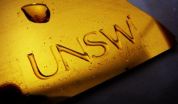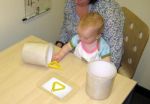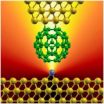New lab-on-a-chip device overcomes miniaturization problems
2014-04-30
(Press-News.org) UNSW Australia chemists have invented a new type of tiny lab-on-a-chip device that could have a diverse range of applications, including to detect toxic gases, fabricate integrated circuits and screen biological molecules.
The novel technique developed by the UNSW team involves printing a pattern of miniscule droplets of a special solvent onto a gold-coated or glass surface.
"We use a class of 'green' solvents called ionic liquids, which are salts that are liquid at room temperature. They are non-volatile, so this overcomes one of the main problems in making useful miniaturised devices - rapid evaporation of the solvents on the chip," says Dr Chuan Zhao, senior author of the study.
"The versatility of our chips means they could have a wide range of prospective functions, such as for use in fast and accurate hand-held sensors for environmental monitoring, medical diagnosis and process control in manufacturing."
The research is published in the journal Nature Communications. It was carried out by Dr Zhao, Christian Gunawan and Mengchen Ge from the UNSW School of Chemistry.
Lab-on-a- chip devices, where chemical reactions are carried out on a miniature scale, are under intensive development because they offer the promise of faster reaction times, reduced use of materials and high yields of product.
Evaporation of solvents on the chip, however, is a big problem because this can affect the concentration of substances and disrupt the reactions. Attempted solutions include containing the solvents within tiny channels or "walls", and having reservoirs to store extra solvent on the chip.
The "wall-less" design developed by the UNSW team - using non-volatile ionic liquids as solvents to fabricate a microarray of droplets chemically anchored to the chip - has several significant advantages.
"Ionic liquids are designer solvents and have wide application. We can now carry out many reactions or analytical procedures in ionic liquids at the micro-scale on a chip with enhanced yields and efficiency," says Dr Zhao.
"These microarray chips can be easily produced in high numbers and are very stable. They can survive being turned upside down and heated to 50 degrees and some can even survive being immersed in another liquid. These properties will be important for commercial applications, including storage and transportation of microchips."
The droplets of ionic liquid are about 50 micrometres across (about half the width of a human hair) and 10 micrometres high.
The UNSW researchers demonstrated several potential uses of the microarrays.
They showed the tiny droplets can act as rapid, sensitive monitors of the presence of a gas, due to their small volume.
They also demonstrated that metal salts dissolved in the droplets could be electrically deposited as microstructures, a technique which could be of use in fabrication of integrated circuits.
Some biological molecules added to the droplets also remained stable and active, opening up the possibility of using the microarrays for diagnostic purposes.
INFORMATION:
Media contacts:
Dr Chuan Zhao: +61 (2) 9385 4645, chuan.zhao@unsw.edu.au
UNSW Science media: Deborah Smith, +61 (2) 9385 7307, +61 (0) 478 492 060, deborah.smith@unsw.edu.au
ELSE PRESS RELEASES FROM THIS DATE:
MRI shows disrupted connections in the brains of young people with ADHD
2014-04-30
OAK BROOK, Ill. – A new study has found that children and adolescents with attention deficit hyperactivity disorder (ADHD) have disrupted connections between different areas of the brain that are evident on resting-state functional magnetic resonance imaging (rfMRI). The results of this research are published online in the journal Radiology.
The findings point to the potential of rfMRI to help provide objectively accurate, early diagnosis of a disorder that affects approximately 5 percent of children and adolescents worldwide.
ADHD is a disorder characterized by age-inappropriate ...
Want a young child to 'help' or 'be a helper'? Choice of words matters
2014-04-30
How do you get a preschooler to help with chores and other household tasks? A new study suggests that adults' word choice can make a big difference.
The study, by researchers at the University of California, San Diego, the University of Washington, and Stanford University, appears in the journal Child Development.
The researchers carried out two experiments with about one hundred and fifty 3- to 6-year-olds from a variety of ethnic and racial backgrounds who came from middle- to upper-middle-class homes. In both experiments, an adult experimenter began by talking to ...
Working memory differs by parents' education; effects persist into adolescence
2014-04-30
Working memory—the ability to hold information in your mind, think about it, and use it to guide behavior—develops through childhood and adolescence, and is key for successful performance at school and work. Previous research with young children has documented socioeconomic disparities in performance on tasks of working memory. Now a new longitudinal study has found that differences in working memory that exist at age 10 persist through the end of adolescence. The study also found that parents' education—one common measure of socioeconomic status—is related to children's ...
Magnitude of quake scales with maturity of fault, suggests new study by German scientist
2014-04-30
SAN FRANCISCO -- The oldest sections of transform faults, such as the North Anatolian Fault Zone (NAFZ) and the San Andreas Fault, produce the largest earthquakes, putting important limits on the potential seismic hazard for less mature parts of fault zones, according to a new study to be presented today at the Seismological Society of America (SSA) 2014 Annual Meeting in Anchorage, Alaska. The finding suggests that maximum earthquake magnitude scales with the maturity of the fault.
Identifying the likely maximum magnitude for the NAFZ is critical for seismic hazard ...
Out of sight but not out of mind: Babies transfer learning from pictures to real objects by 9 months
2014-04-30
Babies begin to learn about the connection between pictures and real-life objects early on. A new study has found that by 9 months, babies can learn about an object from a picture of it and can transfer that learning to the real object when they come across it.
The study, by researchers at Royal Holloway, University of London and the University of South Carolina, appears in Child Development, the journal of the Society for Research in Child Development.
"The study should interest any parent or caregiver who has ever read a picture book with an infant," says Jeanne L. ...
Babies recognize real-life objects from pictures as early as 9 months
2014-04-30
Babies begin to learn about the connection between pictures and real objects by the time they are nine-months-old, according to a new study by scientists at Royal Holloway, University of London, and the University of South Carolina.
The research, published today in Child Development, found that babies can learn about a toy from a photograph of it well before their first birthday.
"The study should interest any parent or caregiver who has ever read a picture book with an infant," said Dr Jeanne Shinskey, from the Department of Psychology at Royal Holloway. "For parents ...
New health system scorecard shows little progress among states from 2007-2012
2014-04-30
New York, NY, April 30, 2014—States made little progress in improving health care access, quality, and outcomes and lowering costs in the five years preceding implementation of the major coverage provisions of the Affordable Care Act (2007-2012), according to the Commonwealth Fund's third state health system scorecard. The majority of states declined or failed to improve on two-thirds of the 34 scorecard indicators that could be tracked over time.
Wide gaps among states persisted since the last scorecard, with top states sometimes performing two to eight times better ...
Direct current, another option to improve the electrical power transmission
2014-04-30
Electricity is normally transmitted by means of alternating current, but it is not the only way and not always the best one.In some cases, high voltage direct current (HVDC) is used. In Spain, for example, there is only one direct current line, the one that connects mainland Spain with the Balearic Islands; all the remaining ones transmit electricity by means of alternating current.
In fact, "direct current continues to be highly suitable for underwater and underground lines," asserted Marene Larruskain, one of the engineers in the UPV/EHU's GISEL group. Furthermore "less ...
A small connection with big implications: Wiring up carbon-based electronics
2014-04-30
Carbon-based nanostructures such as nanotubes, graphene sheets, and nanoribbons are unique building blocks showing versatile nanomechanical and nanoelectronic properties. These materials which are ordered in the nanoscale, that is, in the dimension of a millionth of millimetre, are promising candidates to envision applications in nanoscale devices, ranging from energy conversion to nano-electronic transistors. A good connection between carbon-based materials and external metallic leads is of major importance in nanodevice performance, an aspect where an important step has ...
Like puzzle pieces, 3-D genomics holds a key to classifying human diseases
2014-04-30
To solve a puzzle, you need to recognize shapes, patterns and a particular kind of order. In much the same way, researchers at McGill University have discovered that the 3D shape of a leukemia cell's genome holds a key to solving the puzzle of human diseases. The researchers report their findings in the open access journal Genome Biology.
McGill professor Josée Dostie, a researcher in the Faculty of Medicine in the department of Biochemistry, focused on the shape made by the region spanning the Homeobox A (HOXA) genes in human cells -- a set of 11 genes encoding proteins ...



